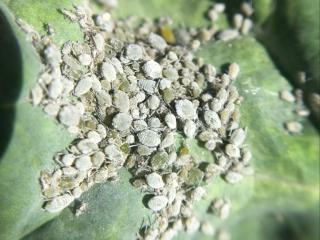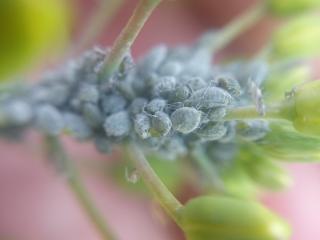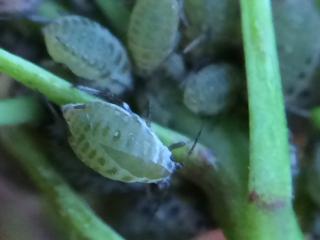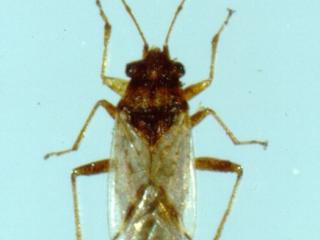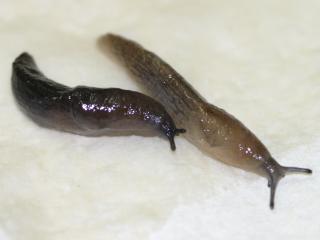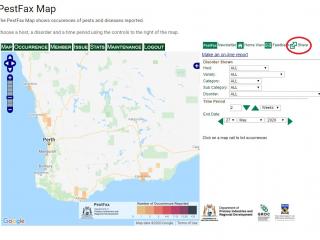Aphids are active
- Kendenup
- Beaumont
Research agronomist Carla Milazzo (DPIRD) has reported finding cabbage and turnip aphids on roadside volunteer canola near Kendenup.
Quenten Knight (Agronomy Focus) has found low levels of winged aphids and some nymphs in 4-6 leaf canola at Beaumont. The aphid species are unknown but were found in growing buds and the underside of canola leaves.
Three aphid species commonly attack canola in Western Australia: cabbage aphid, turnip aphid and green peach aphid (GPA).
Cabbage aphids form dense bluish grey colonies covered with fine whitish powder on flowering heads in spring. They also establish on crowns and under leaves in the vegetative phase. Infestations usually first appear as 'hotspots' along the edge of crops in the paddock. The adult aphid is dull or greyish-green. GRDC recently released a Managing cabbage aphid video.
Turnip aphids infest canola crops in a similar way to cabbage aphids, usually first appearing along crop edges. Turnip aphid colonies establish around growing tips and flowering spikes and often establish in 'hotspots' in the paddock. Aphids have a light waxy coating, which is not as pronounced as the powdery cover of the cabbage aphid. Adults are olive to greyish green, usually with dark bars on the abdomen.
Turnip and cabbage aphids are the two aphids species which commonly infest mid to late-season canola, while green peach aphids are more common early in the season.
Green peach aphids (GPA) occur on the underside of canola leaves of young plants and tend to be more evenly distributed in the paddock. The GPA varies in colour from shiny pale yellow-green to mid-green, orange or pink.
GPA is an important vector of a number of plant viruses including turnip yellows virus (TuYV), cauliflower mosaic virus (CaMV), turnip mosaic virus (TuMV) and cucumber mosaic virus (CMV), all of which damage canola.
Managing canola aphids
Crops early in the season tend to outgrow aphid damage particularly if there are good growing conditions. The cooler the weather the slower the lifecycle of the aphid and the less offspring they produce.
Identify the canola aphids in the crop early.
If you do identify GPA in your crop, monitor and only spray if seedling crops are moisture stressed and/or have high numbers of GPA on the plant so the plant is unable to outgrow GPA feeding damage.
Aphid activity will slow down if cold and wet weather conditions are experienced.
Australian GPA populations are known to have resistance to four different chemical groups – synthetic pyrethroids (for example, alpha-cypermethrin), organophosphates (for example, dimethoate), carbamates (for example, pirimicarb) and neonicotinoids. Recently evidence of the green peach aphid (Myzus persicae, GPA) developing metabolic resistance to sulfoxaflor (Transform™) has been confirmed for the first time in Australia, after a small number of aphid populations from Esperance were shown to have reduced sensitivity to the insecticide. For more information see the 2019 PestFax Issue 5 article First signs of low-level resistance evolving to Transform™ detected in isolated WA green peach aphid populations .
To limit the spread and curb the further evolution of resistance, it is critical that sulfoxaflor (Transform®) is used judiciously and as part of a sound insecticide resistance management strategy. For more information refer to GRDC’s Resistance Management Strategy for the Green Peach Aphid in Australia Grains.
Growers are asked to keep a close eye on establishing canola crops this year and to contact Dr Paul Umina (cesar) on +61 (0)3 9349 4723 if aphids survive a Transform™ application.
Pirimicarb and sulfoxaflor are currently registered for aphid control in canola crops in WA.
Yield loss from cabbage and turnip aphids, is more likely to occur when flowering spikes are colonised. If more than 20% of plants are infested with colonies of canola aphids, control measures should be considered to avoid yield losses
For more insecticide information refer to DPIRD’s 2019 Winter Spring Insecticide Guide.
For more information on identifying and managing canola aphids see DPIRD’s;
- Aphid management in canola crops page
- Diagnosing canola aphids page
- 2017 Protecting WA Crops Issue 3 newsletter Aphids – WA’s insect problem children
- Aphids in your crops YouTube video.
For more information contact Research scientists Svetlana Micic, Albany on +61 (0)8 9892 8591 or Dustin Severtson, Northam on +61 (0)8 9690 2160.
Article authors: Cindy Webster (DPIRD Narrogin) and Svetlana Micic (DPIRD Albany).
African black beetle larvae (cockchafers) found in emerging barley
- Condingup
Research agronomist King yin Lui (DPIRD) recently found African black beetle (ABB) larvae (cockchafers) in an emerging one leaf barley crop near Condingup. A large proportion of the crop was yet to emerge so there was no visible feeding damage.
Cockchafers are usually found in proximity to kikuyu pastures, however in recent seasons many of the paddocks that have been reported as having cockchafers have been continuously cropped minimum tillage paddocks that are not near kikuyu pastures.
Crops after pasture are more likely to be damaged.
The ABB is a soil dwelling insect. Larvae are ‘C’ shaped, creamy-white with dark heads, have three pairs of legs on the thorax and can grow up to 25mm long.
The adults beetles are 12-14mm long, cylindrical and glossy black in colour.
Large populations of ABB adults and larvae can chew cereals and perennial pasture plant parts that are below ground, resulting in bare patches. Adults chew plants at or just beneath ground level, leaving frayed parts. Adults either chew right through the stem or ‘ring bark’ bigger plants.
The adult beetles can come to the surface at night but are usually very difficult to eradicate because they predominantly feed underground and avoid contact with surface applied insecticides. The insecticide needs to penetrate the soil surface where the larvae are.
For further information visit the DPIRD's Diagnosing African black beetle and Identifying soil beetle pests pages.
For more information contact research scientists Svetlana Micic, Albany on +61 (0)8 9892 8591 or Dustin Severtson, Northam on +61 (0)8 9690 2160.
Article author: Cindy Webster (DPIRD Narrogin).
Rutherglen and cotton seed bugs
- Badgingarra
- Dandaragan
- Borden
An Agworld user has reported finding rutherglen bugs in a lupin crop near Badgingarra.
Wayne Birch (Nutrien Ag Solutions) reports finding rutherglen bugs in GT50 canola near Dandaragan. The crop was at the cotyledon stage and there was no visible plant damage.
Brent Pritchard (Farmanco) reports finding high numbers of cotton seed bugs in a germinating cereal crop near Borden. These can easily be confused with Rutherglen bug. Control is not warranted.
Rutherglen bug adults are 4mm long, have clear wings folded flat on the back, are grey-brown-black in colour and are very mobile.
The nymphal or immature stages of Rutherglen bug can look quite different to the adults as nymphs are a dark red colour with a swollen pear shaped body. In nymphs wings are absent or they have small wing buds when viewed under magnification. Any nymphs that become adults can be expected to survive winter as adults and to commence breeding in early spring.
Damage from the rutherglen bugs is similar to mite sucking in that seedlings will become stunted, discoloured and distorted. Rutherglen bugs do most damage to moisture stressed plants.
Cotton seed bug (Oxycarenus arctatus) adults are about 3mm long with a black and white body. Nymphs are black with a conspicuous blood-red abdomen. They are soft bodied and can be easily squashed - releasing a bad smell.
The cotton seed bug is a seed and fruit feeder, which occasionally swarms on cultivated plants including cotton, stone fruits and some vegetables. It is not usually considered a broadacre pest.
Rutherglen and cotton seed bugs are often associated with paddock weeds that germinated with summer/early autumn rains. Rutherglen bugs are especially partial to goosefoot, which is also commonly called mint weed and coon bugs prefer malvaceous plants such as marshmallow weed.
Where weeds have been left uncontrolled close to seeding, surviving rutherglen bugs may pose a threat to emerging crops under dry and sunny conditions.
Both bugs prefer warm dry conditions and will become inactive and die out with prolonged cold and wet winter weather patterns.
Most emerging crops will not have sufficiently high populations of rutherglen bugs to warrant spraying but where they are in large numbers chemical control of rutherglen bugs may be difficult with repeat sprays sometimes necessary against re-invading adults or late nymphal stages.
For registered insecticide recommendations for bugs refer to DPIRD’s 2020 Autumn/Winter Insecticide Guide.
For more information see DPIRD’s Diagnosing rutherglen bug and cesar’s Cotton seed bug pages.
For more insect information contact research scientists Svetlana Micic, Albany on +61 (0)8 9892 8591 or Dustin Severtson, Northam on +61 (0)8 9690 2160.
Article author: Cindy Webster (DPIRD Narrogin) and Svetlana Micic (DPIRD Albany).
Snails are laying eggs and black-keeled slugs are feeding
- Mount Barker
Dissections of conical snails collected from the Mount Barker Research station by DPIRD staff have revealed that conical snails are laying eggs. These eggs are expected to hatch in the next week if they haven’t already started hatching.
Research agronomist Sarah Belli (DPIRD) also reports that there has been black-keeled slug activity under the Mount Barker camera at night time over the past month. Their albumen gland is well developed indicating slugs are laying eggs and dissections have found slugs have food in their guts meaning they are actively feeding.
There are two slug species that are pests of broadacre crops the black keeled slug and the reticulated slug. Other slug species can be present in the paddock. The black-keeled slug is usually black with a prominent ridge down the back. It burrows to a depth of 20cm or more. For more information refer to DPIRD’s Diagnosing slugs in crops page.
Irregular pieces chewed from leaves and shredded leaf edges are typical of snail and slug presence in crops. Damage to canola and legume crops can be difficult to detect if seedlings are chewed down to the ground during emergence. Emerging canola is especially susceptible to damage.
Growers should monitor crops for damage and fencelines at night for snail and slug activity, slug damage can be difficult to detect if seedlings are chewed to ground level. Slug numbers of low as 1 per square metre can be damaging to a germinating canola crop. Refer to DPIRD’s suggested snail and slug threshold numbers in broadacre crops.
Baiting is the only control method available to growers after crops emerge and baiting will have reduced effectiveness as there is a lot of green material that provides an alternative food source for the slugs and snails.
Even bait coverage increases the likelihood of slugs or snails encountering the bait and feeding on the bait. DPIRD’s SnapBait app assists with calibrating bait spreaders.
Trials suggest 30 baits per square metre give good control.
Baiting needs to be concluded 8 weeks before harvest as there is zero tolerance for bait contamination at harvest.
For more information on slug and snail control visit:
- DPIRD’s 2020 PestFax Pre-season Issue article Now is a good time to manage snails before egg laying occurs
- DPIRD’s Identification and control of pest slugs and snails for broadacre crops in WA page
- GRDC’s Bash’Em Burn’Em Bait’Em: Integrated snail management in crops and pastures publication
- GRDC’s Snail baiting as part of an integrated pest management strategy video.
For more information contact Sarah Belli, Research agronomist, Albany on +61 (0)436 826 937, King Yin Lui, Research agronomist, Esperance on +61 (0)472 848 519 or Svetlana Micic, Research Officer, Albany on +61 (0)427 772 051.
Article author: Cindy Webster (DPIRD Narrogin)
Article input: Sarah Belli (DPIRD Albany) and King yin Lui (DPIRD Esperance).
Fall armyworm management advice for broadacre crops is available online
The exotic pest fall armyworm (FAW), Spodoptera frugiperda, was first detected in Western Australia in Kununurra, in the Kimberley region, in March 2020. It has also been found in several locations around Broome.
The FAW larvae are a concern to horticultural and grain growers as they can cause significant production losses by feeding on more than 350 plant species, including cotton, maize, rice, sorghum, wheat, fruit and vegetable crops. It is worth noting that in addition to cereals, canola and pulse crops, lucerne and C4 grasses are also listed as potential hosts for this species.
The potential of FAW to migrate into the southern grain producing areas of Western Australia, such as areas of the Wheatbelt and Great Southern, and damage crops at various growth stages is not yet known.
Growers should be vigilant and aware of this new pest when monitoring cereal, canola and pulse crops for pests.
FAW larvae can look similar to other armyworm species and other caterpillars that grow to a similar size (3-4cm), such as Helicoverpa (native budworm) and cutworms. For information on identifying this pest refer to DPIRD’s Fall Armyworm in Western Australia page and How to identify fall armyworm video.
If you suspect you have found FAW in your crops please make a report by using the MyPestGuide Reporter app or contact DPIRD’s Pest and Disease Information Service (PaDIS) by email or phone +61 (0)8 9368 3080.
DPIRD have recently updated their FAW webpage to include management and other information relevant to the grains industry (cereals, canola and pulses). This includes permits for insecticides should FAW be identified and damage crops. For more information refer to DPIRD’s Fall armyworm in Western Australia page.
For more information on FAW refer to;
- DPIRD’s 2020 PestFax Pre-Season Issue article Fall armyworm
- DPIRD’s Fall armyworm in Western Australia Introduction video
- Queensland Department of Agriculture and Fisheries Fall armyworm – should you be concerned? Beatsheet article.
For more information contact Dustin Severtson, Research scientist, Northam on +61 (0)8 9690 2160.
Article author: Cindy Webster (Narrogin DPIRD).
Article input: Dusty Severtson (Northam DPIRD).
Do you use the PestFax map?
The PestFax map is a portal for a wealth of recorded insect and disease information for the WA grainbelt. Growers and consultants may be surprised at how useful this tool is, if you are not already regularly generating maps.
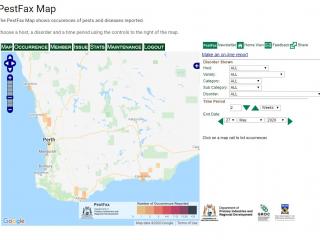
What is the PestFax map?
The PestFax map provides a visual display of all of the pests and diseases occurrences reported by the WA grains industry to the PestFax service since 1996. There are also corresponding PestFacts map services in the eastern states.
Are many maps are generated by the public?
In 2019 an impressive 6,943 maps were generated for WA in total, with 4,736 maps generated to view “All disorders” reported in 2019.
The top five disorder maps generated were; powdery mildew (471), diamondback moth (377), Australian plague locust (182) sclerotinia stem rot (179) and native budworm (149).
How do I check what has been reported?
Viewers can choose a host, a disorder and a time period in the PestFax map, see screenshot below.
Reported occurrences are displayed as a colour coded squares. Viewers can click on any square to see more detail, see screenshot below.
Viewers can compare numbers and patterns of reports between seasons, and they can watch how pests and diseases move during a season.
Maps can be produced showing individual disorders, totals of disorder categories, or totals of all disorders.
I have found an insect or disease in my crop or pasture – how do I report it?
Reports can be made to the PestFax team in a multitude of ways;
- Download and use the PestFax Reporter app
- Email the PestFax team via PestFax@dpird.wa.gov.au
- Phone PestFax newsletter editor Cindy Webster on +61 (0)0404 819 534
- Make an online report via the PestFax map.
The more reports that are received and mapped the more forewarned growers and consultants are of emerging pest issues in their areas. Reporting both the presence and absence of common disease or pests multiple times is encouraged so that a more detailed ‘picture’ of the distribution and severity of a problem can be built up.
How do I share a generated map with someone else?
Click 'Share' and copy the map link. The map link can be put in a document or sent in a message, and readers can click the link to see the same map.
Positive map feedback
Informal discussions with consultants, agronomists, researchers, other agribusiness practitioners and farmers indicate that a wide diversity of people are using PestFax maps for a variety of reasons.
Chemical company representatives have commented that the maps of seasonal pest and disease incidence and regional movement through time provide valuable support for the logistical movement of chemical stocks to country retail outlets where they are most likely to be needed.
Private and public researchers have provided feedback that they are using the PestFax maps for early awareness of pest and disease outbreaks so that they can respond by prompt establishment of trial sites in specific target areas or can follow the outbreak progression through time.
Comparison of maps of seasonal variations within years and geographical locations helps researchers to identify trends in pest incidence and support development of predictive models.
Consultants and agronomists are eager to follow early season maps of disease and pest incidence so that they can alert their clients to monitor and prepare for likely pest and disease threats.
Similarly, editors of regional and state-wide media outlets seek out PestFax maps to provide them with signals for the production of timely news articles.
PestFax map project history
The PestFax map service was developed through two successive projects jointly funded from 2010-2016 by the Grains Research and Development Corporation (GRDC) and DPIRD (formerly Department of Agriculture and Food, Western Australia). These projects were done in partnership with cesar Australia, the South Australian Research and Development Institute (SARDI) and the Australian Cereal Rust Control Program (ACRCP) at the University of Sydney.
For more information or to generate a map visit DPIRD’s PestFax map.
For more information contact Art Diggle, Principal Research Scientist, South Perth on +61 (0)8 9368 3563.
Article author: Cindy Webster (DPIRD Narrogin).

